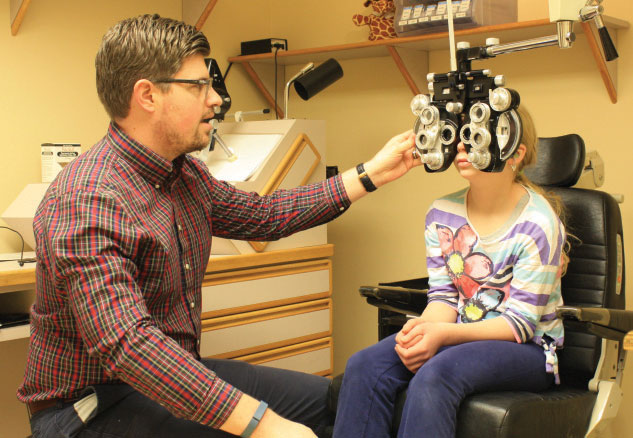 |
Q:
What myopia control methods are available, and which patients have the best outcomes with each?
A:
“The putative optical cue for myopia management is myopic defocus—light focused in front of the retina,” according to Jeffrey J. Walline, OD, PhD, Associate Dean for Research at Ohio State University College of Optometry. He says two types of contact lenses provide myopic defocus to slow eye growth: multifocal and orthokeratology (ortho-K).
Contact Lens Options
While only center-distance soft multifocal designs have been investigated, Donald Mutti, OD, PhD, also at Ohio State, says center-near designs may also be effective.1-4 Dr. Walline says patients usually require an extra -0.50D to -0.75D in their distance prescription for optimal vision and myopic defocus.
Ortho-K slows axial elongation, slowing myopia in the process.5-7 Dr. Walline notes that no specific ortho-K design has been proven superior to another when managing myopia, so practitioners have several options.
 |
| Ample communication with young patients helps ensure compliance and allows you to find the option that suits them best. Photo by Jeffrey J. Walline, OD, PhD. |
Patient Selection
Dr. Walline says soft multifocals and ortho-K have similar success rates with myopia management. He recommends basing your contact lens choice on your patient’s personal circumstances and lifestyle needs to give them the best treatment to slow myopia progression at the earliest possible age.
Dr. Mutti says patients who are motivated to wear contact lenses and old enough to care for them are the best candidates for soft multifocals. He notes that patient selection is more complicated for ortho-K, as there is more risk involved in overnight wear. Evidence suggests that the effects of ortho-K are greater in those with larger pupils, steeper corneas and moderate myopia to make for an adequate amount of peripheral myopic defocus.8
Dr. Mutti says he considers soft multifocals to be his first choice for any patient who is a good candidate for contact lens wear. He explains that he prefers the safety profile of daily lenses to that of overnight lenses and believes dailies are the most appropriate choice for the long-term wear demands of myopia.
Other Options
Another method of myopia management is atropine.5,6 Current evidence indicates that 0.05% may be an optimal concentration to provide significant treatment with minimal side effects.6 Dr. Walline notes that atropine may provide better short-term myopia management than contact lenses. He adds, however, that the mechanism of atropine’s myopia management is unknown because it doesn’t slow axial elongation as much as contact lenses.
Dr. Mutti adds that combining optical and pharmaceutical approaches is another, more aggressive option. Dr. Walline says there is conflicting evidence about whether combining atropine and ortho-K provides better management than ortho-K alone and a lack of knowledge about combining soft multifocals and atropine. He concludes that combination therapy should be reserved for patients whose myopia is progressing the fastest.
Today, myopic children are better equipped to deal with their condition than ever before. While one universal method that works just as well for every patient doesn’t exist, clinicians have multiple treatment options available.
| 1. Aller TA, Liu M, Wildsoet CF. Myopia control with bifocal contact lenses: a randomized clinical trial. Optom Vis Sci. 2016;93(4):344-52. 2. Anstice NS, Phillips JR. Effect of dual-focus soft contact lens wear on axial myopia progression in children. Ophthalmology. 2011;118(6):1152-61. 3. Lam CS, Tang WC, Tse DY, et al. Defocus incorporated soft contact (DISC) lens slows myopia progression in Hong Kong Chinese schoolchildren: a 2-year randomised clinical trial. Br J Ophthalmol. 2014;98(1):40-5. 4. Walline JJ, Greiner KL, McVey ME, et al. Multifocal contact lens myopia control. Optom Vis Sci. 2013;90(11):1207-14. 5. Charm J, Cho P. High myopia-partial reduction ortho-k: a 2-year randomized study. Optom Vis Sci. 2013;90(6):530-9. 6. Cho P, Cheung SW. Retardation of myopia in orthokeratology (ROMIO) study: a 2-year randomized clinical trial. Invest Ophthalmol Vis Sci. 2012;53(11):7077-85. 7. Walline JJ, Jones LA, Sinnott LT. Corneal reshaping and myopia progression. Br J Ophthalmol. 2009;93(9):1181-5. 8. Santodomingo-Rubido J, Villa-Collar C, Gilmartin B, et al. Factors preventing myopia progression with orthokeratology correction. Optom Vis Sci. 2013;90(11):1225-36. |

